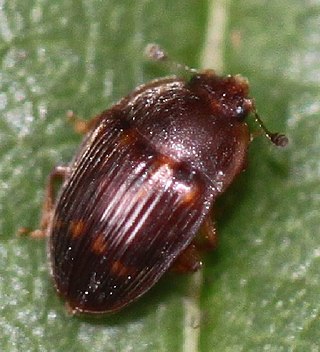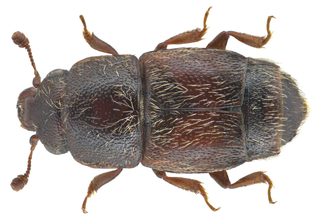
The sap beetles, also known as Nitidulidae, are a family of beetles.

Carpophilus melanopterus is a species of sap-feeding beetles in the family Nitidulidae. It is found in Central America and North America.
Carpophilus rufus is a species of sap-feeding beetle in the family Nitidulidae. It is found in Central America and North America.
Carpophilus antiquus is a species of sap-feeding beetle in the family Nitidulidae. It is found in North America.
Carpophilus marginatus is a species of sap-feeding beetle in the family Nitidulidae. It is found in North America.
Carpophilus discoideus is a species of sap-feeding beetle in the family Nitidulidae. It is found in North America.
Carpophilus yuccae is a species of sap-feeding beetle in the family Nitidulidae. It is found in North America.
Carpophilus freemani, or Freeman's sap beetle, is a species of sap-feeding beetle in the family Nitidulidae. It is found in North America, Oceania, and Europe.

Carpophilus mutilatus, known generally as the confused sap beetle or flower beetle, is a species of sap-feeding beetle in the family Nitidulidae. It is found in Oceania, Europe, North America, and temperate Asia.

Urophorus is a genus of sap-feeding beetles in the family Nitidulidae. There are at least two described species in Urophorus.
Carpophilus brevipennis is a species of sap-feeding beetle in the family Nitidulidae. It is found in Central America, North America, and South America.
Colopterus truncatus is a species of sap-feeding beetle in the family Nitidulidae. It is found in the Caribbean Sea, Central America, North America, and South America.This particular sap beetle is thought to be one of the principal sap beetle vectors of oak wilt fungus in Minnesota.
Carpophilus sayi is a species of sap-feeding beetle in the family Nitidulidae. It is found in North America, and named after Thomas Say.
Carpophilus tempestivus is a species of sap-feeding beetle in the family Nitidulidae. It is found in the Caribbean Sea and North America.
Carpophilus brachypterus is a species of sap-feeding beetle in the family Nitidulidae. It is found in North America.
Fabogethes is a genus of pollen beetles in the family Nitidulidae. There are at least two described species in Fabogethes.

Stelidota is a genus of sap-feeding beetles in the family Nitidulidae. There are about 15 described species in Stelidota.

Carpophilus hemipterus, the dried-fruit beetle, is a species of sap-feeding beetle in the family Nitidulidae. It is found in North America, Oceania, and Europe.
Carpophilus ligneus is a species of sap-feeding beetle in the family Nitidulidae. It is found in Europe and Northern Asia.

Carpophilus dimidiatus, the cornsap beetle, is a species of sap-feeding beetle in the family Nitidulidae. It is found in Oceania, Europe, and North America.








